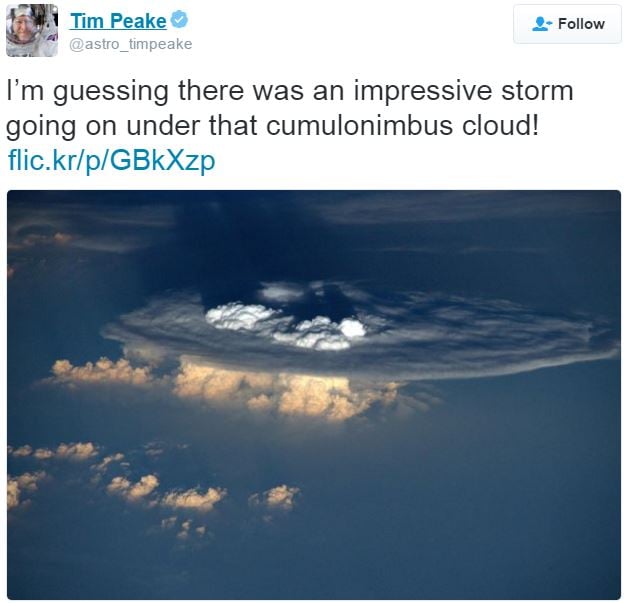British astronaut Tim Peake has captured another spectacular photograph from space, this time of a fierce thunderstorm – a massive cumulonimbus cloud – which appears to be venting its anger over Nepal. When he posted the image online on Tuesday morning, he did not mention where on Earth the storm was, but most viewers agree it was probably Nepal.
Ever since 15th December, when he boarded the International Space Station, which orbits Earth at a distance of 400 kilometres (248 miles), he has taken hundreds of photographs. In fact, he is making quite a name for himself as a gifted space photographer.
As seen in the picture below, the cloud has a flat top, which occurs when it reaches a very high altitude and goes head-on against the stratosphere (50+km or 30+miles above the Earth’s surface), with the temperature rising with the altitude.
 A huge cumulonimbus cloud. These types of clouds are capable of producing lightning and other dangerous severe weather, including tornadoes. Cumulonimbus progress from overdeveloped cumulus congestus clouds and may develop further as part of a supercel. (Image: twitter.com/astro_timpeake)
A huge cumulonimbus cloud. These types of clouds are capable of producing lightning and other dangerous severe weather, including tornadoes. Cumulonimbus progress from overdeveloped cumulus congestus clouds and may develop further as part of a supercel. (Image: twitter.com/astro_timpeake)
The stratosphere’s environment provides a kind of invisible barrier which makes the clouds spread out.
In the middle of the flat top there are some bubbles. These are caused by intense updrafts which break through the stratosphere. When this occurs, it means that it is probably a very powerful storm.
Lightning storm videoed
In February this year, Major Peake posted a stunning video of a lightning storm that was taking place over North Africa and Turkey.
The time-lapse video footage showed many bright flashes that appeared in rapid succession.
When he posted the footage of the lightning storm online, he wrote: “Amazing how much lightning can strike our planet in a short time.”
Amazing how much lightning can strike our planet in a short time #Principia #timelapsehttps://t.co/XijV5E1pI0
— Tim Peake (@astro_timpeake) February 9, 2016
Major Peake and other International Space Station (ISS) crew members were orbiting over North Africa at the time, going towards Turkey and then Russia – while the ISS crossed the Mediterranean and the Black Sea they were able to see three continents – Europe, Africa and Asia.
Video of Aurora taken from ISS
The Aurora, often called polar lights (northern/southern lights), is a natural light display we can see in the sky. It is more commonly seen at high latitude – far from the equator in the Arctic and Antarctic regions. In the southern hemisphere the lights are called aurora australis, and aurora borealis in the northern hemisphere.
#Aurora skimming the sunrise. #timelapsehttps://t.co/awQ87WathN
— Tim Peake (@astro_timpeake) April 23, 2016
Major Peake videoed an Aurora, which we can observe appearing above Earth’s horizon.
We are fortunate that Major Peake likes sharing the wonders he witnesses from the weightless environment of the International Space Station as it orbits our planet.
Beautiful image of London
In January, Major Peake captured a beautiful image of London at night in all its glory.
#London midnight Saturday – I’d rather be up here…but only just!! #toughcall https://t.co/DB9LeKgOAC pic.twitter.com/RxX7wYc9Zs
— Tim Peake (@astro_timpeake) January 31, 2016
In the picture you can see the major trunk roads spreading out from the centre like the luminous strands of a spider’s web, as well as the city lights.
The winding black snake that goes across the middle of the picture is the river Thames.
Major Peake joked that he would prefer to be aboard the ISS than down in London on a Saturday night, and then added jokingly ‘but only just!’
Video – Tim Peake completes London Marathon
On Sunday, Major Peake completed the London Marathon in space in 3 hours 25 minutes and 21 seconds.
